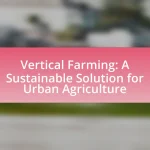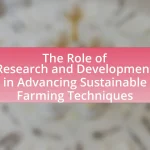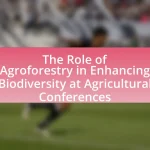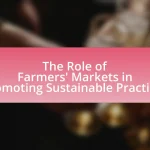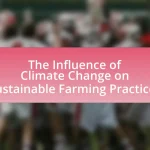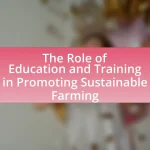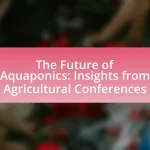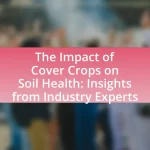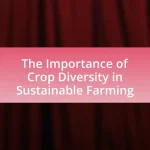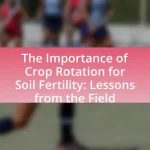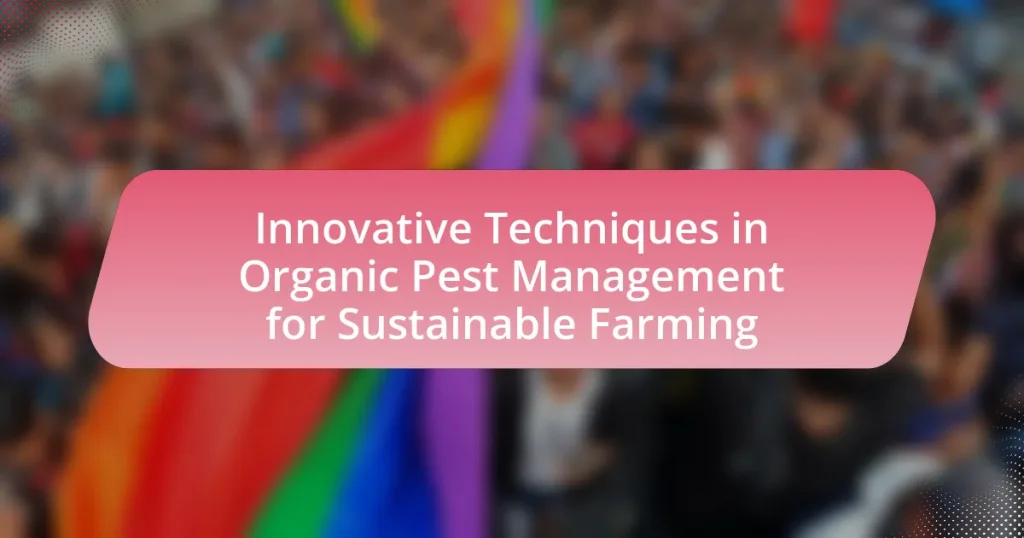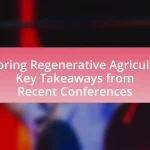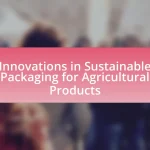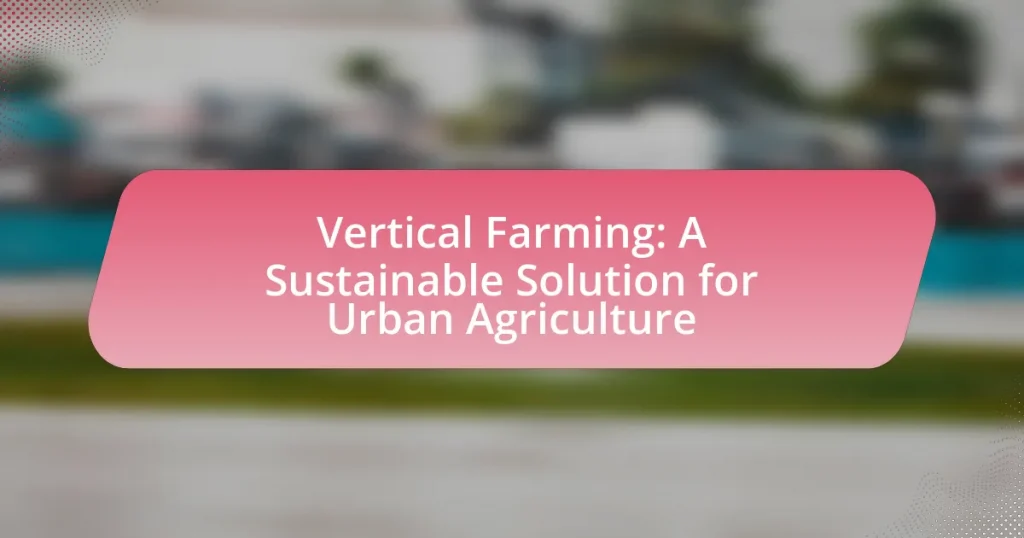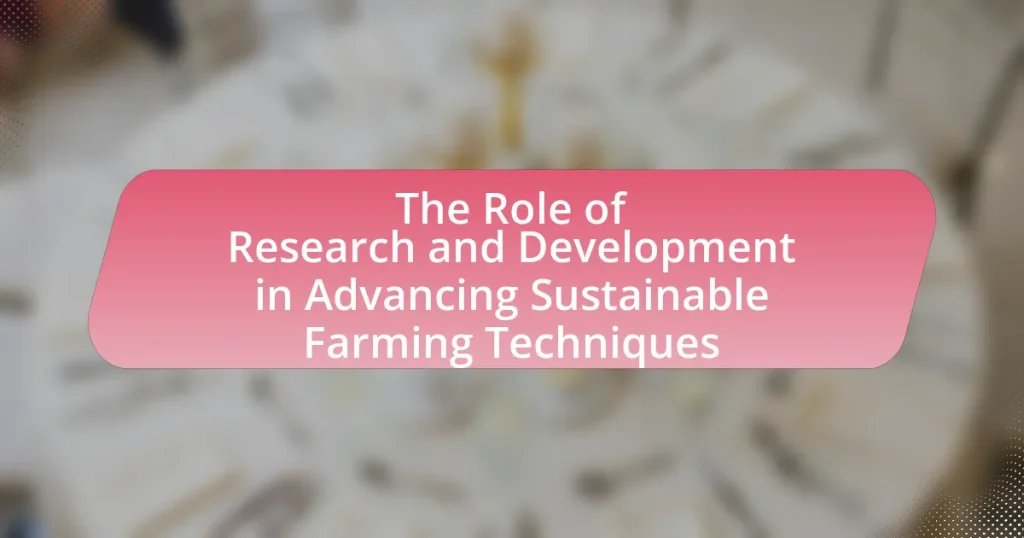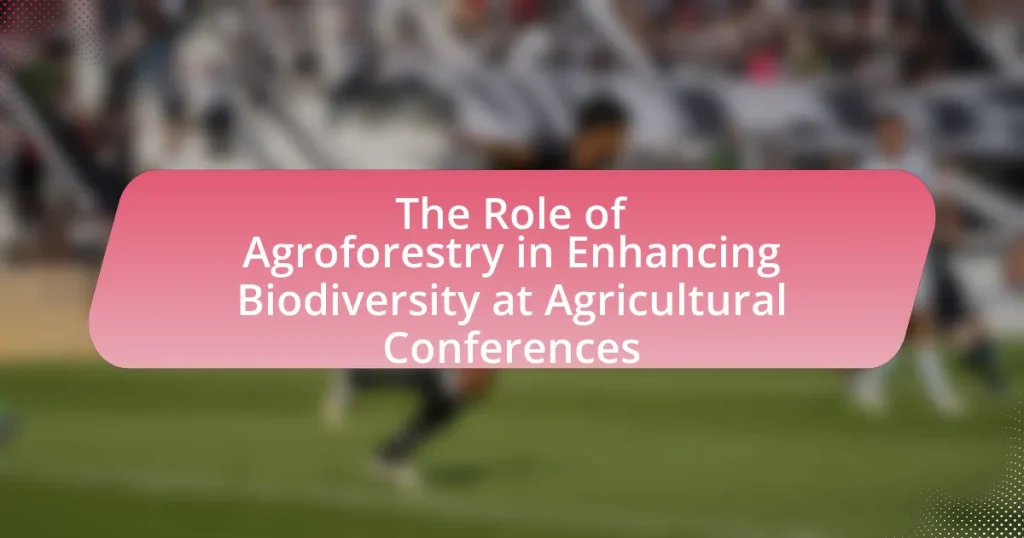Innovative techniques in organic pest management are essential for sustainable farming, focusing on methods such as biopesticides, integrated pest management (IPM), and the use of beneficial insects. These approaches prioritize ecological balance and reduce reliance on synthetic chemicals, enhancing crop yields and promoting environmental health. Key principles include prevention, monitoring, and control, with an emphasis on biological and cultural practices. The article explores how these innovative techniques differ from traditional methods, their environmental benefits, and the challenges farmers face in implementation, while also highlighting the role of technology and consumer preferences in shaping future practices.
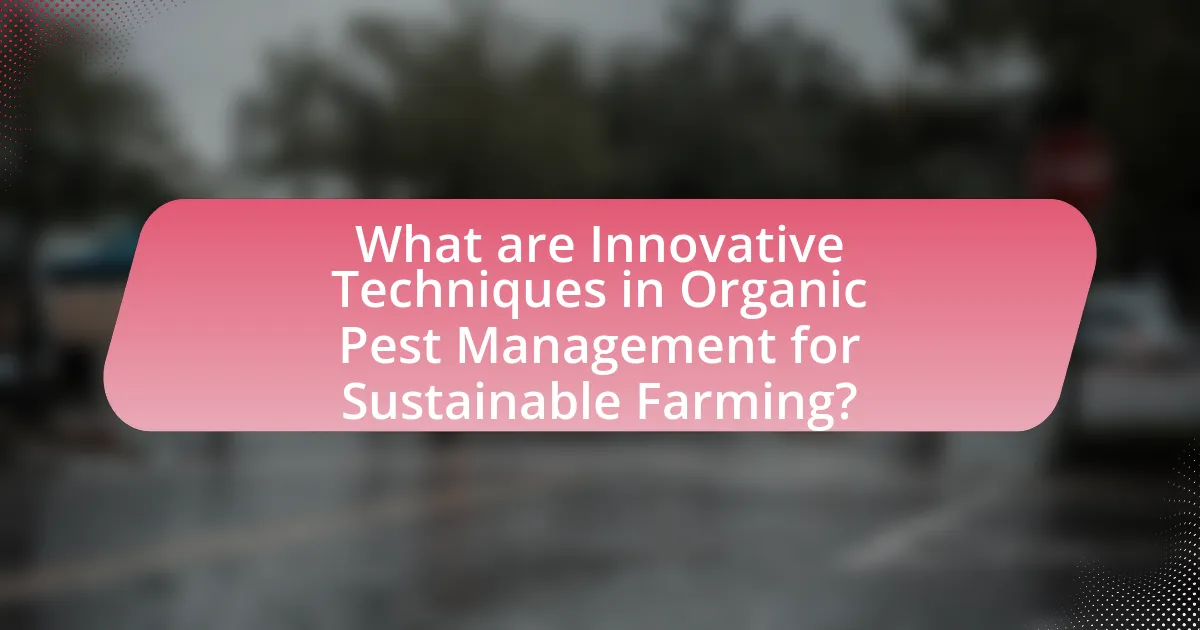
What are Innovative Techniques in Organic Pest Management for Sustainable Farming?
Innovative techniques in organic pest management for sustainable farming include the use of biopesticides, integrated pest management (IPM), and the implementation of beneficial insects. Biopesticides, derived from natural materials, effectively target specific pests while minimizing harm to non-target organisms. Integrated pest management combines biological, cultural, and mechanical practices to manage pest populations sustainably, reducing reliance on chemical inputs. The introduction of beneficial insects, such as ladybugs and parasitic wasps, provides natural pest control, enhancing ecosystem balance. These methods have been shown to improve crop yields and promote environmental health, as evidenced by studies indicating that farms employing IPM can reduce pesticide use by up to 50% while maintaining productivity.
How do these techniques differ from traditional pest management methods?
Innovative techniques in organic pest management differ from traditional pest management methods primarily in their reliance on ecological principles and non-chemical approaches. Traditional methods often depend on synthetic pesticides that can harm beneficial organisms and lead to resistance, while innovative techniques emphasize biological control, habitat manipulation, and the use of natural predators to manage pest populations sustainably. For instance, research has shown that integrating crop diversity and using pheromone traps can significantly reduce pest outbreaks without the adverse effects associated with chemical pesticides, thus promoting a healthier ecosystem.
What are the key principles of organic pest management?
The key principles of organic pest management include prevention, monitoring, and control. Prevention focuses on creating an environment that discourages pests through practices such as crop rotation, selecting pest-resistant varieties, and maintaining healthy soil. Monitoring involves regularly checking for pest populations and damage to make informed decisions about interventions. Control methods prioritize non-chemical approaches, such as biological control using natural predators, mechanical controls like traps, and cultural practices that disrupt pest life cycles. These principles are supported by research indicating that integrated pest management strategies can reduce reliance on synthetic pesticides while maintaining crop yields and ecosystem health.
How do innovative techniques enhance these principles?
Innovative techniques enhance the principles of organic pest management by improving pest control efficacy and promoting ecological balance. For instance, the use of integrated pest management (IPM) combines biological control, habitat manipulation, and resistant crop varieties, leading to reduced pesticide reliance and increased biodiversity. Research indicates that farms employing IPM can reduce pest populations by up to 50% while maintaining crop yields, demonstrating the effectiveness of these innovative approaches. Additionally, advancements in technology, such as precision agriculture, allow for targeted interventions that minimize environmental impact and optimize resource use, further aligning with sustainable farming principles.
Why is organic pest management important for sustainable farming?
Organic pest management is important for sustainable farming because it reduces reliance on synthetic pesticides, promoting ecological balance and biodiversity. This approach enhances soil health and water quality by minimizing chemical runoff, which can harm non-target species and ecosystems. Studies show that farms utilizing organic pest management practices can increase beneficial insect populations, leading to natural pest control and improved crop yields. For instance, research published in the journal “Agriculture, Ecosystems & Environment” indicates that organic farming systems can reduce pest populations by up to 50% through the use of natural predators and biopesticides, demonstrating the effectiveness of organic methods in maintaining sustainable agricultural practices.
What environmental benefits does organic pest management provide?
Organic pest management provides several environmental benefits, including enhanced biodiversity, reduced chemical runoff, and improved soil health. By utilizing natural predators and biopesticides, organic pest management promotes a balanced ecosystem, which supports a variety of species and reduces the reliance on synthetic chemicals. Studies indicate that organic farming systems can increase species richness by up to 30% compared to conventional methods, fostering a more resilient agricultural environment. Additionally, organic practices minimize chemical runoff into waterways, protecting aquatic ecosystems and improving water quality. Furthermore, organic pest management contributes to soil health by enhancing microbial activity and organic matter, which can lead to better nutrient cycling and soil structure. These practices collectively support sustainable farming and contribute to long-term environmental health.
How does it contribute to soil health and biodiversity?
Innovative techniques in organic pest management contribute to soil health and biodiversity by enhancing microbial activity and promoting diverse plant communities. These methods, such as crop rotation and the use of cover crops, improve soil structure and nutrient availability, which fosters a thriving ecosystem. Research indicates that practices like intercropping can increase soil organic matter by up to 30%, leading to improved soil fertility and resilience. Additionally, these techniques support beneficial organisms, such as pollinators and natural pest predators, thereby increasing overall biodiversity in agricultural systems.
What challenges do farmers face when implementing these techniques?
Farmers face several challenges when implementing innovative techniques in organic pest management for sustainable farming. One significant challenge is the initial cost of adopting new technologies, which can be prohibitive for small-scale farmers. For instance, the investment in organic pesticides or advanced monitoring systems may exceed their budget, leading to reluctance in adoption. Additionally, farmers often encounter a lack of knowledge and training regarding these techniques, which can hinder effective implementation. Research indicates that approximately 60% of farmers report insufficient access to educational resources on organic practices, impacting their ability to utilize these methods effectively. Furthermore, the variability in pest resistance and environmental conditions can complicate the effectiveness of organic pest management strategies, making it difficult for farmers to achieve consistent results.
What are the common misconceptions about organic pest management?
Common misconceptions about organic pest management include the belief that it is ineffective, overly labor-intensive, and that it relies solely on natural pesticides. In reality, organic pest management employs a variety of strategies, including biological control, crop rotation, and habitat manipulation, which have been shown to effectively manage pests. Research indicates that organic farming can yield comparable results to conventional methods, with studies demonstrating that organic systems can reduce pest populations through integrated pest management techniques. Additionally, while organic practices may require more initial planning and knowledge, they often lead to long-term sustainability and reduced chemical dependency, contradicting the notion of excessive labor.
How can farmers overcome these challenges?
Farmers can overcome challenges in organic pest management by adopting integrated pest management (IPM) strategies that combine biological control, cultural practices, and the use of organic pesticides. Implementing IPM allows farmers to reduce pest populations while minimizing environmental impact. For example, research from the University of California Agriculture and Natural Resources indicates that using beneficial insects, such as ladybugs and lacewings, can effectively control aphid populations without harming the ecosystem. Additionally, crop rotation and intercropping can disrupt pest life cycles, further enhancing pest control. These methods not only improve pest management but also contribute to sustainable farming practices.
How can farmers effectively integrate innovative techniques into their practices?
Farmers can effectively integrate innovative techniques into their practices by adopting precision agriculture technologies, such as drones and soil sensors, which enhance crop monitoring and resource management. These technologies allow farmers to collect real-time data on soil health, moisture levels, and pest populations, enabling targeted interventions that improve yields and reduce chemical usage. For instance, a study published in the journal “Agricultural Systems” found that precision agriculture can increase crop productivity by up to 15% while decreasing input costs by 10-20%. By utilizing these innovative tools, farmers can make informed decisions that align with sustainable farming practices and organic pest management strategies.
What are the best practices for adopting these techniques?
The best practices for adopting innovative techniques in organic pest management for sustainable farming include thorough research and understanding of the specific pest challenges faced, integrating multiple pest control strategies, and continuous monitoring of pest populations. Research indicates that farmers who utilize integrated pest management (IPM) techniques, which combine biological, cultural, and mechanical controls, experience a significant reduction in pest-related crop losses. For instance, a study published in the Journal of Economic Entomology found that IPM can reduce pesticide use by up to 50% while maintaining crop yields. Additionally, educating farmers on the life cycles of pests and beneficial insects enhances the effectiveness of these techniques, as highlighted by the USDA’s Sustainable Agriculture Research and Education program. Implementing these practices fosters a more resilient agricultural ecosystem and promotes long-term sustainability.
How can farmers measure the success of their pest management strategies?
Farmers can measure the success of their pest management strategies by evaluating pest population levels, crop yield, and economic returns. Monitoring pest populations through regular scouting and using traps allows farmers to assess the effectiveness of their management techniques. Additionally, comparing crop yields before and after implementing pest management strategies provides insight into their impact on productivity. Economic analysis, including cost-benefit assessments, further quantifies the financial viability of these strategies. Studies indicate that integrated pest management can reduce pest populations by up to 50% while increasing yields by 20%, demonstrating measurable success in pest control efforts.
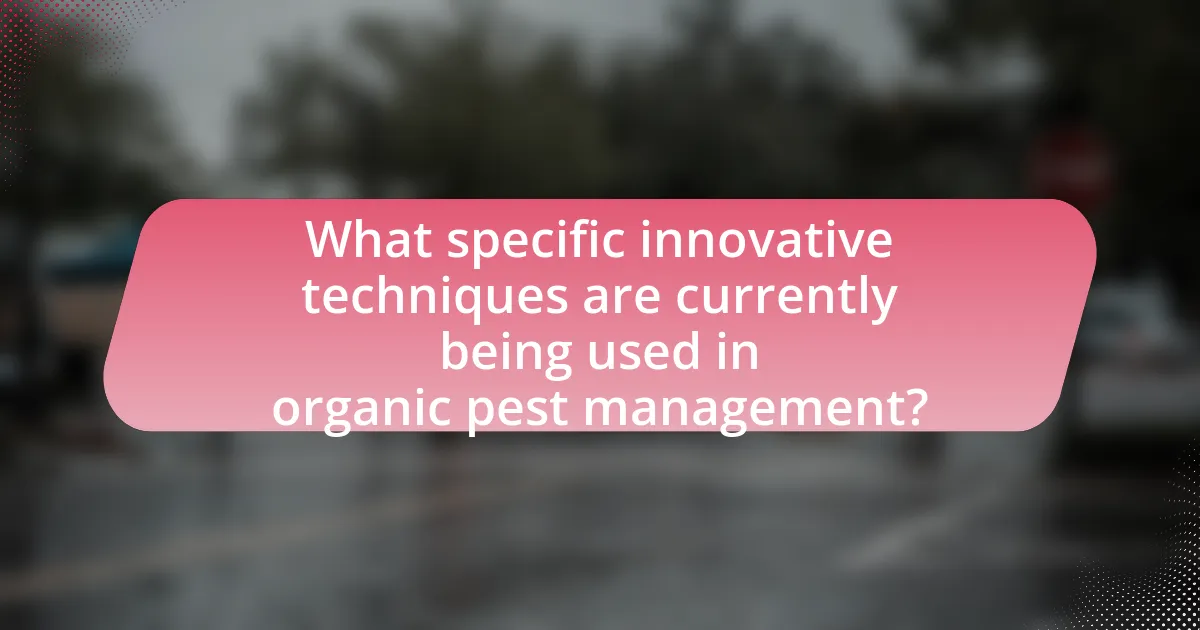
What specific innovative techniques are currently being used in organic pest management?
Innovative techniques currently used in organic pest management include the use of biopesticides, integrated pest management (IPM), and the application of beneficial insects. Biopesticides, derived from natural materials, effectively target specific pests while minimizing harm to non-target organisms. Integrated pest management combines biological, cultural, and mechanical practices to manage pest populations sustainably, reducing reliance on chemical inputs. The introduction of beneficial insects, such as ladybugs and parasitic wasps, helps control pest populations naturally. These techniques are supported by research indicating their effectiveness in maintaining crop health while adhering to organic farming standards.
How do biological control methods work in organic pest management?
Biological control methods in organic pest management work by utilizing natural predators, parasites, or pathogens to suppress pest populations. These methods aim to maintain ecological balance and reduce reliance on synthetic pesticides. For instance, introducing ladybugs can effectively control aphid populations, while nematodes can target soil-dwelling pests. Research has shown that biological control can lead to a significant reduction in pest numbers, with studies indicating up to 80% pest suppression in certain crops when biological agents are employed. This approach not only protects crops but also promotes biodiversity and sustainability in agricultural systems.
What types of beneficial organisms are commonly used?
Beneficial organisms commonly used in organic pest management include predatory insects, parasitoids, and beneficial microorganisms. Predatory insects such as ladybugs and lacewings are effective in controlling aphid populations, while parasitoids like parasitic wasps target pest larvae, reducing their numbers. Additionally, beneficial microorganisms, including certain bacteria and fungi, can suppress pest populations and enhance plant health by promoting nutrient uptake. Research has shown that integrating these organisms into pest management strategies can significantly reduce reliance on chemical pesticides, thereby supporting sustainable farming practices.
How effective are these biological controls compared to chemical pesticides?
Biological controls are generally less effective than chemical pesticides in terms of immediate pest suppression but offer long-term sustainability benefits. While chemical pesticides can rapidly reduce pest populations, biological controls, such as natural predators or microbial agents, often require time to establish and may not achieve the same level of immediate impact. Research indicates that biological controls can lead to sustainable pest management by enhancing ecosystem balance and reducing chemical residues in the environment. For instance, a study published in the journal “Biological Control” found that integrating biological controls with reduced chemical use can maintain crop yields while minimizing environmental harm.
What role does crop rotation play in pest management?
Crop rotation plays a crucial role in pest management by disrupting the life cycles of pests and diseases. By alternating the types of crops grown in a specific area, farmers can reduce the prevalence of pests that thrive on particular plants. For example, rotating crops can prevent the buildup of soil-borne pathogens and pests that are specific to certain crops, thereby minimizing their impact on future plantings. Research has shown that crop rotation can lead to a significant reduction in pest populations; studies indicate that rotating crops can decrease pest infestations by up to 50%. This method not only enhances soil health but also promotes biodiversity, which further aids in pest control.
How does crop diversity impact pest populations?
Crop diversity significantly reduces pest populations by disrupting their life cycles and habitats. When multiple crop species are grown together, it creates a more complex ecosystem that can support natural predators of pests, thereby lowering pest abundance. Research indicates that fields with higher crop diversity can experience up to 50% fewer pest incidents compared to monoculture systems, as diverse crops can confuse pests and reduce their ability to locate hosts. Additionally, diverse plantings can enhance the resilience of crops against pest outbreaks, as seen in studies conducted by the University of California, which found that polycultures can lead to improved pest control through increased biological diversity.
What are the best practices for implementing crop rotation?
The best practices for implementing crop rotation include selecting diverse crops, planning rotations based on plant families, and timing planting and harvesting to optimize soil health and pest management. Diverse crops help break pest and disease cycles, while rotating among different plant families reduces nutrient depletion and enhances soil fertility. For instance, legumes can fix nitrogen in the soil, benefiting subsequent crops. Research indicates that effective crop rotation can increase yields by up to 20% and reduce the need for chemical fertilizers and pesticides, promoting sustainable farming practices.
How can technology enhance organic pest management techniques?
Technology can enhance organic pest management techniques by providing advanced tools for monitoring, data analysis, and targeted interventions. For instance, precision agriculture technologies, such as drones and remote sensing, allow farmers to identify pest populations and crop health in real-time, enabling timely and specific responses. Research indicates that the use of drones can increase pest detection accuracy by up to 90%, significantly improving management efficiency. Additionally, data analytics and machine learning algorithms can analyze historical pest data to predict outbreaks, allowing for proactive measures. These technological advancements not only optimize pest control strategies but also minimize the reliance on chemical inputs, aligning with the principles of organic farming.
What are the latest technological advancements in pest monitoring?
The latest technological advancements in pest monitoring include the use of artificial intelligence (AI) and machine learning algorithms to analyze pest behavior and predict infestations. These technologies enable real-time data collection through IoT devices, such as smart traps and sensors, which monitor environmental conditions and pest populations. For instance, a study published in the journal “Computers and Electronics in Agriculture” highlights how AI-driven image recognition can identify pest species with over 90% accuracy, significantly improving response times and management strategies. Additionally, drone technology is being utilized for aerial surveillance, allowing farmers to cover large areas efficiently and detect pest issues early. These advancements enhance the precision and effectiveness of pest management in sustainable farming practices.
How can precision agriculture contribute to organic pest management?
Precision agriculture enhances organic pest management by utilizing data-driven technologies to monitor and manage pest populations more effectively. This approach allows farmers to apply organic pest control methods, such as beneficial insects or organic pesticides, precisely where and when they are needed, reducing overall pesticide use and minimizing environmental impact. For instance, studies have shown that precision agriculture techniques, such as remote sensing and soil moisture monitoring, can identify pest hotspots, enabling targeted interventions that improve pest control efficacy while adhering to organic standards.
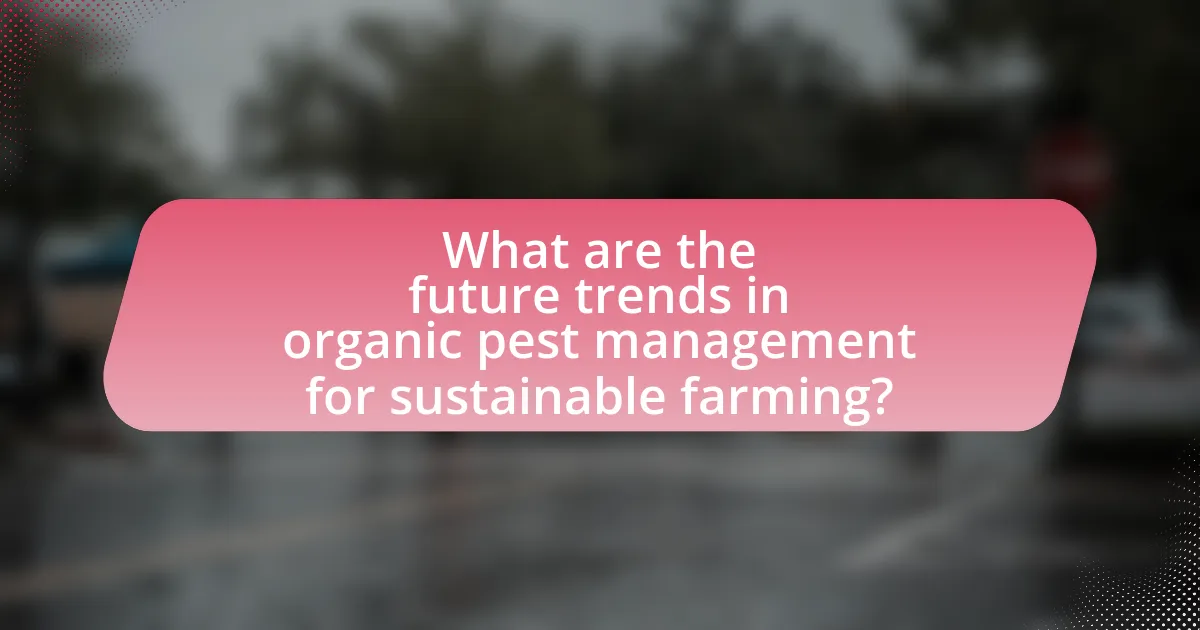
What are the future trends in organic pest management for sustainable farming?
Future trends in organic pest management for sustainable farming include the increased use of biopesticides, integrated pest management (IPM) strategies, and advancements in precision agriculture technologies. Biopesticides, derived from natural materials, are gaining popularity due to their effectiveness and minimal environmental impact, with the global biopesticide market projected to reach $10.5 billion by 2025. Integrated pest management combines biological, cultural, and mechanical practices to control pests sustainably, reducing reliance on chemical inputs. Additionally, precision agriculture technologies, such as drones and sensors, enable farmers to monitor pest populations and apply treatments more efficiently, leading to reduced pesticide use and enhanced crop health. These trends reflect a growing commitment to sustainable practices in agriculture, aligning with consumer demand for organic products and environmental stewardship.
How is research shaping the future of organic pest management?
Research is shaping the future of organic pest management by developing innovative techniques that enhance pest control while maintaining ecological balance. For instance, studies have shown that integrating biological control methods, such as the use of beneficial insects, can significantly reduce pest populations without harming non-target species. Research published in the journal “Agricultural Systems” highlights that the application of pheromone traps and biopesticides has led to a 30% increase in crop yield in organic farming systems. Additionally, advancements in genetic research are enabling the identification of pest-resistant plant varieties, which can further reduce reliance on chemical interventions. These findings underscore the critical role of research in advancing sustainable practices in organic pest management.
What emerging techniques are being developed?
Emerging techniques in organic pest management for sustainable farming include the use of biopesticides, integrated pest management (IPM) strategies, and precision agriculture technologies. Biopesticides, derived from natural materials, are being developed to target specific pests while minimizing harm to beneficial organisms. Integrated pest management combines biological, cultural, and mechanical practices to control pest populations sustainably. Precision agriculture utilizes data analytics and technology to optimize pest control measures, ensuring that interventions are timely and effective. These techniques are supported by research indicating their effectiveness in reducing chemical pesticide use while maintaining crop yields.
How can farmers stay informed about new innovations?
Farmers can stay informed about new innovations by actively engaging with agricultural extension services, attending workshops, and participating in online forums. Agricultural extension services provide up-to-date information on best practices and new technologies, while workshops offer hands-on experience and networking opportunities with experts. Online forums and social media platforms allow farmers to share insights and learn from peers about the latest advancements in organic pest management. Research indicates that farmers who utilize these resources are more likely to adopt innovative techniques, leading to improved sustainability in farming practices.
What role do consumer preferences play in the evolution of organic pest management?
Consumer preferences significantly influence the evolution of organic pest management by driving demand for sustainable agricultural practices. As consumers increasingly prioritize health, environmental sustainability, and ethical farming, they favor products that are free from synthetic pesticides and fertilizers. This shift in consumer behavior has prompted farmers and agricultural companies to adopt organic pest management techniques that align with these preferences, such as integrated pest management (IPM) and the use of natural predators. Research indicates that the organic food market has grown substantially, with sales reaching $62 billion in the U.S. in 2020, reflecting a clear consumer trend towards organic products. Consequently, the need to meet consumer expectations has accelerated the development and implementation of innovative organic pest management strategies, ensuring that agricultural practices remain viable and competitive in a market increasingly driven by consumer choice.
How are market demands influencing farming practices?
Market demands are significantly influencing farming practices by driving the adoption of sustainable and organic methods. As consumers increasingly prefer organic produce, farmers are compelled to implement innovative techniques in pest management that align with these preferences. For instance, a study by the Organic Trade Association reported that organic food sales reached $62 billion in 2020, reflecting a growing market demand for organic products. This shift encourages farmers to utilize integrated pest management strategies that minimize chemical use, such as biological control and crop rotation, to meet consumer expectations for environmentally friendly practices.
What are the implications for sustainable farming practices?
Sustainable farming practices lead to enhanced environmental health, improved soil quality, and increased biodiversity. These practices, such as crop rotation, organic pest management, and reduced chemical inputs, contribute to long-term agricultural productivity while minimizing ecological damage. For instance, a study published in the journal “Agriculture, Ecosystems & Environment” by Reganold and Wachter (2016) found that organic farming systems can yield comparable results to conventional systems while promoting soil health and reducing pollution. This evidence underscores the positive implications of sustainable farming for both agricultural viability and ecosystem preservation.
What practical tips can farmers follow to enhance their organic pest management strategies?
Farmers can enhance their organic pest management strategies by implementing integrated pest management (IPM) techniques, which combine biological, cultural, and mechanical practices. Utilizing beneficial insects, such as ladybugs and lacewings, can naturally control pest populations, while crop rotation disrupts pest life cycles and reduces infestations. Additionally, employing physical barriers like row covers can protect crops from pests without chemicals. Research indicates that farms practicing IPM have seen a 30% reduction in pest-related crop losses compared to conventional methods, demonstrating the effectiveness of these strategies in sustainable farming.
How can farmers create a pest management plan tailored to their specific needs?
Farmers can create a pest management plan tailored to their specific needs by conducting a thorough assessment of their unique agricultural environment, including crop types, pest populations, and local ecological conditions. This assessment allows farmers to identify the specific pests affecting their crops and evaluate the effectiveness of various management strategies, such as biological control, crop rotation, and the use of organic pesticides. Research indicates that integrated pest management (IPM) approaches, which combine multiple strategies based on local conditions, can significantly reduce pest populations while minimizing environmental impact. For instance, a study published in the Journal of Integrated Pest Management found that farms implementing IPM saw a 30% reduction in pest-related crop damage compared to those using conventional methods. By continuously monitoring pest populations and adjusting their strategies accordingly, farmers can ensure their pest management plans remain effective and sustainable.
What resources are available for ongoing education and support in organic pest management?
Resources available for ongoing education and support in organic pest management include university extension programs, online courses, and professional organizations. University extension programs, such as those offered by land-grant universities, provide research-based information and workshops on organic pest management practices. Online platforms like eOrganic offer free webinars and articles that cover various aspects of organic pest management. Additionally, organizations such as the Organic Farming Research Foundation and the National Sustainable Agriculture Coalition provide resources, networking opportunities, and advocacy for organic farmers, ensuring they have access to the latest research and techniques in the field.
